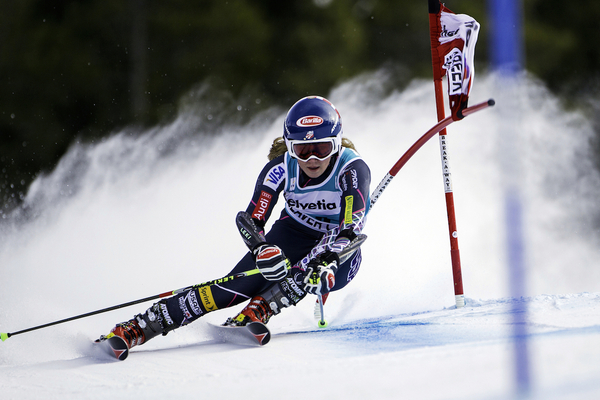The Local newsletter is your free, daily guide to life in Colorado. For locals, by locals.
One of the biggest events on Colorado’s 2015 calendar arrives just two months into the year: the FIS Alpine World Ski Championships, which will be held in Vail and Beaver Creek from February 2 to 15. As you’ll read in our February issue (hitting newsstands Friday), $58 million worth of facelifts went toward ensuring that two of our state’s most beloved mountains are in tip-top shape for the competition’s much-anticipated return to U.S. soil (the event was held in Vail and Beaver Creek in 1999).
Weekend warriors already know how hectic the high country can be, and with more than 600 athletes (representing more than 70 countries) taking to the slopes—not to mention hundreds of thousands of spectators expected—the popular ski areas will be more abuzz than ever. Here, we offer a straightforward guide on what you need to know before you head to the hills, from how to get around to using the correct lingo, and more.

TRANSPORTATION
By Car/Bus: The easiest way to reach the race courses—the majority of which will be held at Beaver Creek; events and medal ceremonies will take place at Vail—is to hop on a free express bus. The vehicles will run every 10 minutes between the ski towns from 5 a.m. to 2 a.m. every day. Expect the ride from Vail’s transportation center to Beaver Creek Village to take about 30 minutes. From there, you’ll hop on a five-minute shuttle to the grandstands. (You can also disembark in Avon before reaching the village.) Insider’s tip: Parking in Vail for the day won’t be free. If you’d rather not drop any cash, direct your car to the Bear or Rodeo lots at the base of Beaver Creek; shuttle buses start at 7 a.m. from these areas.
By Your Own Two Feet: Want to get a bit of a workout? Instead of taking the shuttle from Beaver Creek Village to the race courses, grab your snowshoes or skis. Trail 2015 is the designated snowshoe route to Red Tail Stadium, measuring 2,015 meters (just under two miles). Expect the excursion, which starts just west of Chair 6, to take about 45 minutes. (Event organizers say anyone in decent hiking shape can do it.) Even better: You don’t need a lift ticket, snowshoe demos will be available for free, and a halfway cafe will be stocked with warm treats. Keep in mind that you’ll be sharing the run with skiers and snowboarders. If you have a lift ticket or pass, consider skiing/snowboarding to the mid-mountain finish area; you can reach Red Tail Stadium for Centennial (Chair 6), the Westin Gondola, or Chair 16 or 18 at Bachelor Gulch. Signs will be abundant on the mountain and will offer different routes based on skier ability.
TIPS & TRICKS
- There are no reserved seats at the finish stadium. Plan to arrive about an hour before the race starts to snag a good spot. And bring blankets to stay warm.
- This is a massive international event. As such, security will be tight. Expect bag checks prior to boarding the race finish shuttle; each person is allowed one bag (9-by-10-by-17 inches or smaller). Again, it’s a good idea to arrive early to medal ceremonies, concerts, and the like if you want a closer view; these events will have capacity limits.
- One of the coolest aspects of this event is that the athletes will be living and hanging out in Vail and Beaver Creek. Which means you can mingle with them outside of signing events. In fact, the competitors ride the same buses as the public down the mountain after a race. Keep your eyes peeled and your cameras ready.
- While almost all races will be held in Beaver Creek, the Nations Team Event, in which teams of four athletes compete side-by-side on giant slalom courses in a knockout bracket format, will be at Golden Peak Stadium at Vail. In other words: Make sure to double check where you’re heading before you get on a bus.
- Worried about remembering all this? Don’t be. Download the Vail 2015 app (free for iPhones and Androids) for handy access to schedules, maps, real-time transportation updates, athlete bios, and more. And then bookmark this page for even more insider details.
LEARN THE LINGO
If you’re like us, you only (kind of) remember the difference between slalom and giant slalom every four years when the Olympics sportscasters keep reminding you. Here’s a simple guide to help you sound smart while chatting up fellow spectators:
Downhill: A race against the clock (the fastest of any ski race, in fact) in which speeding skiers—they can exceed 80 mph—aim to make it down the mountain fastest through a minimum number of gates (and without wiping out).
Super-G: This speed event is similar to downhill but requires more frequent turns (a characteristic of giant slalom, as well).
Slalom: This technical event features plenty of fast, quick turns. Gates are “placed in varying combinations,” so winning athletes are often the ones who choose the best lines down the run. The skier with the fastest combined time of two runs wins.
Giant Slalom: Considered the most technical event, athletes race down a quicker and more open course than the slalom, which has many short, fast turns. The number of gates is based on the vertical drop of the hill. Athletes take two runs; the times are added together, and the fastest time wins.
Alpine Combined: An all-around race (formerly called Super Combined) that requires athletes to complete one run of downhill and one of slalom on the same day. Often, competitors have less than two hours to rest between segments. The winner is the person with the lowest combined time for the two runs.
Check 5280.com throughout the World Championships for our lineup of athletes to watch, off-mountain events (think: concerts galore), and where to grab a bite between races.








